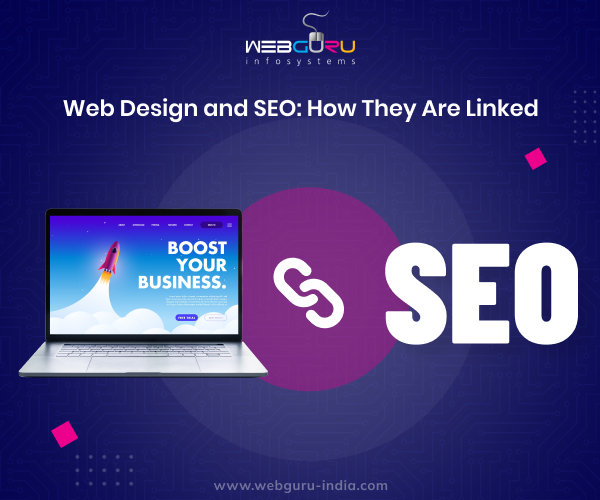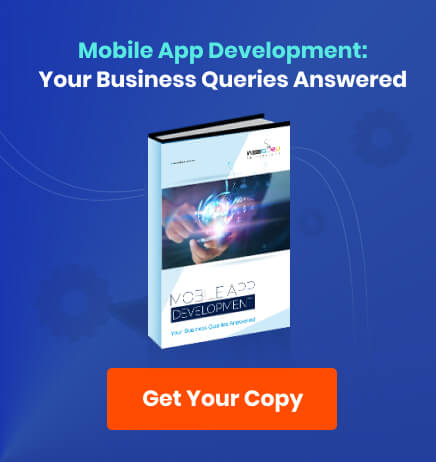Home Blog Website Design Services Web Design and SEO: How They Are Linked
Web Design and SEO: How They Are Linked
- 21 Jul / 2023
- 2,414 views
- 8 Min Read

A strong online presence has become imperative for businesses to stay competitive. Whether you’re running an e-commerce store, a blog, or a corporate website, the key to success lies in being easily discoverable by your target audience. This is where search engine rankings play a crucial role. Higher rankings mean better visibility, increased organic traffic, and ultimately, more conversions.
However, for good rankings, content-based SEO isn’t enough. You need to ensure that your chosen website design services create a website that is SEO–optimized as well. In this article, we’ll explore how web design can significantly impact your website’s search engine rankings and provide you with actionable strategies to optimize your design for better SEO performance.
Understanding Search Engine Rankings and SEO
Before delving into the connection between web design and SEO, let’s grasp the basics of search engine rankings and how SEO works.
Search engines like Google use complex algorithms to evaluate and rank websites based on various factors. While these algorithms are continually evolving, they primarily consider the following aspects:
- Relevance: How well a website’s content matches the user’s search query.
- Authority: The credibility and trustworthiness of a website, often determined by the quantity and quality of backlinks it receives.
- User Experience: The overall experience a website provides to its visitors, including page loading speed, mobile-friendliness, and navigation.
SEO, on the other hand, refers to the practice of optimizing your website to improve its search engine rankings. By strategically incorporating relevant keywords, creating high-quality content, and adhering to technical best practices, you can enhance your site’s visibility and attract organic traffic.
The Impact of Web Design on SEO
Responsive and Mobile-Friendly Design
In an increasingly mobile-first world, optimizing your website for mobile devices is no longer an option; it’s a necessity. Google’s mobile-first indexing means that the search engine primarily uses the mobile version of your site to rank its pages. Here’s how you can ensure your design caters to mobile users:
- Implement a responsive design: A responsive website adjusts its layout based on the screen size, providing users with a seamless experience on any device, including foldable device resolutions.
- Prioritize mobile speed: Mobile users expect fast-loading pages. Compress images, leverage browser caching, and use AMP (Accelerated Mobile Pages) to enhance mobile speed.
Page Loading Speed and Performance
Page loading speed directly affects user experience, bounce rates, and search engine rankings. If your website takes too long to load, users are likely to abandon it, leading to a negative impact on your SEO efforts. At the very least, your website’s core web vitals need to be up to mark. Improve your site’s performance with the following strategies:
- Optimize images: Compress images without sacrificing quality to reduce their file size.
- Minimize HTTP requests: Combine CSS and JavaScript files and leverage browser caching.
- Use a content delivery network (CDN): A CDN distributes your website’s static resources across multiple servers worldwide, reducing latency and improving loading times.
Website Architecture and Navigation
A well-organized website structure not only makes it easier for users to navigate but also assists search engine bots in crawling and indexing your pages efficiently. Consider the following design practices:
- Clear and intuitive navigation: Use logical menus and breadcrumbs to help users find their way around your site easily.
- XML sitemaps: Submit XML sitemaps to search engines to ensure all your essential pages get indexed.
- Internal linking: Link relevant pages within your site to spread link equity and improve discoverability.
User Experience (UX) and SEO
Search engines prioritize user-centric websites that offer a positive experience. An intuitive and enjoyable user experience encourages visitors to stay longer, reducing bounce rates and signaling search engines that your site is valuable.
- Clear calls-to-action (CTAs): Place prominent and compelling CTAs throughout your site to guide users toward conversion.
- Readable and scannable content: Organize your content with headings, bullet points, and short paragraphs for easy readability.
- Minimize intrusive interstitials: Avoid pop-ups that hinder user access to content, as they may negatively impact mobile rankings.
High-Quality Content and SEO
While web design plays a significant role in user engagement, the content itself is equally crucial for SEO (if not more). High-quality, relevant content establishes your authority and keeps users coming back for more. Here’s how web design can complement your content strategy:
- Formatting for readability: Use font styles, sizes, and colors that enhance readability and make the content visually appealing.
- Clear typography hierarchy: Organize your headings (H1, H2, H3, etc.) to create a logical flow of information for both users and search engines.
On-Page SEO and Web Design
On-page SEO involves optimizing individual pages to improve their search engine rankings. Several web design elements play a role in on-page SEO:
1. Title Tags, Meta Descriptions, and Headings
- Well-crafted title tags: Include relevant keywords in your title tags and keep them under 60 characters to ensure they display correctly in search results.
- Compelling meta descriptions: Write concise and engaging meta descriptions to entice users to click on your links.
- Proper use of headings: Use H1 for the main title, H2 for subheadings, and so on, to create a hierarchical structure that search engines can understand.
2. Image Optimization
- Alt text: Include descriptive alt text for images to make them accessible to visually impaired users and enhance image search optimization.
- Image compression: Compress images to reduce their file size and improve page loading speed.
3. URL Structure and Permalinks
- User-friendly URLs: Use readable and descriptive URLs that provide users and search engines with valuable information about the page’s content.
- Avoiding URL duplication: Ensure each page has a unique URL to prevent duplicate content issues.
4. Rich Snippets and Structured Data
- Rich snippets: Use structured data markup to enhance your search listings with additional information, such as reviews, ratings, and events.
- Improved visibility: Rich snippets can improve your click-through rate (CTR) and boost your site’s visibility in search results.
Web Design and Off-Page SEO
Off-page SEO involves optimizing factors outside of your website that influence its rankings. While many off-page elements are beyond your direct control, your web design can still have an indirect impact:
1. Link Building and Design
- Attractive content: High-quality design and visually appealing content can attract more natural backlinks from other websites.
- Social sharing: Encourage social sharing of your content by incorporating social media buttons and creating shareable visuals.
2. Branding and Trustworthiness
- Consistent branding: Maintain a consistent brand identity across your website to build trust and credibility with users.
- Trust signals: Use trust badges, customer testimonials, and security seals to instill confidence in your website.
Technical SEO and Web Design
Technical SEO refers to optimizing the technical aspects of your website to improve its search engine rankings. Web design plays a significant role in technical SEO:
1. Website Crawling and Indexing
- Crawlable design: Ensure your website’s pages are easily accessible by search engine bots. Avoid using JavaScript or other elements that may block crawlers.
- XML sitemaps: Create and submit XML sitemaps to help search engines understand your site’s structure and index its pages efficiently.
2. HTTPS and Security
- SSL certificate: Implement HTTPS on your website to secure data transmission and build user trust. Google considers HTTPS as a ranking factor.
Testing and Measuring Web Design Impact on SEO
To ensure your web design optimizations yield positive results, monitor and measure the impact on your SEO performance:
1. Tools for Testing Web Design and SEO Performance
- Google PageSpeed Insights: Evaluate your website’s loading speed and get suggestions for improvement.
- Google Lighthouse: Analyze your website’s performance, accessibility, and SEO compliance.
- Google Analytics: Track user behavior, traffic sources, and other essential metrics to understand your site’s performance.
2. Conducting A/B Tests for Web Design Elements
- A/B testing: Experiment with different design variations to identify what works best for your audience.
- Test and refine: Continually measure the results and refine your design to enhance user experience and SEO performance.
Future Trends
As technology evolves, so do search engine algorithms and web design trends. Here are some future considerations to keep in mind:
1. The evolving landscape of search engine algorithms
- Voice search: Optimize your website for voice search queries as voice-enabled devices become more popular.
- Artificial intelligence: Consider how AI can impact both search behavior and user experience.
2. How emerging technologies influence web design and SEO
- Augmented reality (AR) and virtual reality (VR): Explore opportunities to integrate AR/VR experiences into your website design.
- Progressive Web Apps (PWAs): Consider adopting PWAs for a faster and more engaging user experience.
Conclusion
Web design and SEO are inherently interconnected. A well-optimized design not only improves user experience but also enhances your website’s search engine rankings. By creating a responsive and mobile-friendly website, prioritizing page loading speed and performance, and crafting high-quality content, you can attract more organic traffic and achieve long-term online success.
Remember to focus on user-centric design, conduct thorough testing, and adapt to emerging trends to stay ahead in the ever-evolving landscape of web design and SEO. By incorporating these strategies, you’ll pave the way for a website that ranks higher, engages users, and drives meaningful results for your business or brand.

Shrutarshi Das
Shrutarshi Das is a purveyor of all things digital, with a particular interest in new technological innovations, photography, and gaming.
3 comments
Leave a Reply

-
1000+
Happy
Clients -
25+
Countries
Served -
19+
Years of
Trust








Hello, every time i used to check website posts here early in the daylight, since i like to learn more and more.
Your ability to demystify SEO and present it in an engaging way is unmatched.
I always look forward to your posts. Keep them coming!
I like this blog very much, Its a real nice spot to read and obtain info.